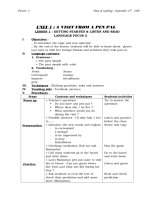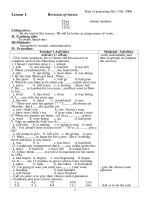litening from unit 1 to 6
Bạn đang xem bản rút gọn của tài liệu. Xem và tải ngay bản đầy đủ của tài liệu tại đây (25.82 KB, 1 trang )
In the UK we eat around the dining table. We follow lots of table manners. Firstly, we use
cutlery – you know, knives, forks and spoons – to eat most of the food. We hold the fork in
the left hand and the knife in the right. You should hold the handle of the knife in your palm
and your fork in the other hand with the prongs pointing downwards. There is also a spoon
and a fork for dessert. When you fi nish eating, you should place your knife and fork with
the prongs upwards on your plate. Secondly, you should never use your own cutlery to take
more food from the serving dish – use the serving spoon. Now if there’s bread on the table,
you can use your hands to take a piece. Then break off a small piece of bread and butter it.
Thirdly, if you are a guest, you have to wait until the host or hostess starts eating and you
should ask another person to pass the food. Next, never chew with your mouth open and
don’t talk with food in your mouth…
Today I’m going to tell you about the xoe dance, a traditional dance of the Thai ethnic
group in Viet Nam. Thai people have followed this spiritual tradition for generations. The
xoe dance expresses people’s working life and wishes for a happy and wealthy life. It is
performed in both public and private gatherings such as celebrations, festivals or family
reunions. The xoe dance has more than 30 forms based on the fi rst six ancient forms. The
most popular form is the xoe vong or ‘circle dance’ because it expresses social unity. People,
young or old alike, join hands to make a circle around the fi re and dance to the music.
Besides the circle dance, there are dances with conical hats, paper fans or scarves. Old
people say they shouldn’t break with this tradition because it refl ects Thai culture and
lifestyle. As a Thai folk song goes, without the xoe dance, the rice won’t grow and people
won’t get married.
A: Good morning. Can I ask you some questions about this festival? B: Yes, of course. A:
What is the festival called? B: Ooc bom boc. It’s held by our ethnic group in Soc Trang on the
14th and 15th evenings of the 10th lunar month. A: Who do you worship at the festival? B:
Our Moon God. We thank him for giving us a good harvest and plenty of fish in the rivers. A:
What do you do during the festival? B: First, we have a worshipping ceremony at home,
under the bamboo archway or at the pagoda. When the moon appears, the old pray to the
Moon God and the children raise their clasped hands to the moon. A: Sounds great! So
what are the off erings? B: Green rice flakes, coconuts, potatoes and pia cakes. A: Do you do
any other activities after that? B: Sure. Then we fl oat beautiful paper lanterns on the river,
and the next evening, we hold thrilling
The Giong Festival is celebrated every year in Phu Linh Commune, Soc Son District, Ha Noi.
This festival commemorates the hero, Saint Giong. He is considered a mythical hero because
he grew from a three-year-old child into a giant overnight. He is worshipped for defending
the country from foreign invaders - the An. Although this festival is held from the 6th to the
12th day of the 4th lunar month, people start preparing traditional clothing for the
procession and for various festival performances one month beforehand. During the
festival, the procession starts at the Mother Temple and goes to Thuong Temple where a
religious ceremony is performed. When night falls, a cheo play is performed. Then the
festivities end with a thanksgiving procession on the 12th. This festival shows our love for
the motherland and the preservation of our cultural heritage.









